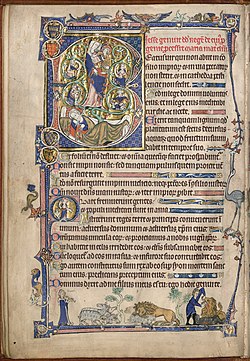Isabella Psalter
| Isabelle Psalter | |
|---|---|
| Psalter of Queen Isabella | |
 Beginning of the Psalter, with initial representing the Tree of Jesse | |
| Illustrated by | Anonymous |
| Audience | Isabella of France |
| Language | Latin and Old French |
| Date | c. 1303–1308 |
| State of existence | Incomplete |
| Manuscript(s) | BSB Cod.gall. 16 |
| Genre | Psalter |
| Length | 131 remaining folios, originally ≥150 |
| Sources | Vulgate |
The Isabella Psalter (BSB Cod.gall. 16), also called the Psalter of Queen Isabella[1] or the Psalter of Isabella of England,[2] is a 14th-century volume containing the Book of Psalms, named for Isabella of France, who is herself depicted in it; it was likely a gift upon her betrothal or marriage.[3] The illuminated manuscript is also notable for its bestiary.
Origin and history of the manuscript
The psalter was produced ca. 1303–1308.[4] Like its "closest relation," the Tickhill Psalter, it shows a French influence and is similar in content and style to the Queen Mary Psalter[5] and the Ormesby Psalter.[6] Like the Queen Mary and Tickhill psalters, and like the Egerton Gospel and the Holkham Picture Bible, some of its captions and illustrations can be traced to the 12th-century Historia scholastica; all these 14th-century manuscripts may have "a thirteenth-century Parisian antecedent, reflected in the Tours Genesis window" (in reference to a window in the clerestory of the Tours Cathedral).[7] It is currently held in the Bavarian State Library, Munich.[6]
According to Donald Drew Egbert, the illuminators belong to the same group that illuminated the Tickhill Psalter.[8] Art historian Ellen Beer, however, states that while there are similarities, Egbert is too quick to identify the illuminators (whom he connects to four other manuscripts as well).[9] According to Beer, two of the illuminators responsible for the Psalter of St. Louis can be recognized in the Isabella Psalter.[10]
Description
The manuscript contains 131 leaves of parchment, and is missing 19 leaves which were separated from the codex at an unknown time. It is a parallel text, with each Psalm appearing in both Latin and Old French. The left-hand pages contain Latin text in black ink, and the right-hand pages contain French text in red ink. The beginning of each principle section of the psalter is marked by a large illuminated initial and marginal scenes from the life of King David. Of the twenty incipit pages originally included in the book, only nine remain. The Latin pages are decorated with 238 initials and marginalia illustrating scenes from the Old Testament, in the style of contemporary bibles moralisées. The French pages are adorned with initials in the form of heraldic blazons throughout, and a bestiary for the first 77 Psalms. Certain animals appear to be associated with particular Psalms, and evoke the moral qualities which the book elevates. The association between Psalms and animals is unusual in medieval texts, and only otherwise appears in the Mary Queen Psalter.[11]
The other distinctive characteristic of the manuscript's iconography is its emphasis on women and their role in the family; the Tree of Jesse, for example, serves as a reminder of Jesus's descent from David by way of Mary. The illustrations related to David focus especially on his wives and concubines, and the other Old Testament images have a similar bent, depicting the marriage of Moses to Tharbis and of Salmon to Rahab, as well as the births of Cain and Samson. Eight scenes are dedicated to Hagar, the concubine of Abraham, and six to the upbringing of Samuel by Hannah.[12]
References
- Notes
- ^ Wier 24
- ^ Sweeney 274.
- ^ Stanton, "The Queen Mary Psalter" 83.
- ^ Weir 77.
- ^ Stanton, "From Eve to Bathsheba" 184.
- ^ a b Egbert, The Tickhill psalter 11.
- ^ Papanicolaou 187.
- ^ Egbert, A sister to the Tickhill psalter
- ^ Beer, "Gotische Buchmalerei" 165.
- ^ Beer, "Pariser Buchmalerei" 79.
- ^ Stanton 2002, pp. 4–9
- ^ Stanton 2002, pp. 9–10
- Bibliography
- Beer, Ellen J. (1962). "Gotische Buchmalerei. Literatur von 1945 bis 1961". Zeitschrift für Kunstgeschichte. 25 (2): 153–65. doi:10.2307/1481459. JSTOR 1481459.
- Beer, Ellen J. (1981). "Pariser Buchmalerei in der Zeit Ludwigs des Heiligen und im letzten Viertel des 13. Jahrhunderts". Zeitschrift für Kunstgeschichte. 44 (1): 62–91. doi:10.2307/1482108. JSTOR 1482108.
- Egbert, Donald Drew (1935). A sister to the Tickhill psalter, the Psalter of Queen Isabella of England: an English gothic manuscript of the early 14th century now in the Bayerische Staatsbibliothek at Munich, Cod. gall. 16. New York City: New York Public Library.
- Egbert, Donald Drew (1932). The Tickhill psalter: an English illuminated manuscript of the early fourteenth century. New York City: The New York Public Library.
- Papanicolaou, Linda Morey (1981). "The Iconography of the Genesis Window of the Cathedral of Tours". Gesta. 20 (1): 179–89. doi:10.2307/766840. JSTOR 766840. S2CID 193440105.
- "Psalter der Königin Isabella von England - BSB Cod.gall. 16". Bavarian State Library. Retrieved 25 May 2011.
- Stanton, Anne Rudloff (2002). "The psalter of Isabelle, Queen of England 1308–1330: Isabelle as the audience". Word & Image. 18 (1): 1–27. doi:10.1080/02666286.2002.10404973 – via Taylor and Francis Online.
- Stanton, Anne Rudloff (2001). The Queen Mary psalter: a study of affect and audience. Philadelphia: American Philosophical Society. ISBN 978-0-87169-916-9.
- Stanton, Anne Rudloff (1997). "From Eve to Bathsheba and Beyond: Motherhood in the Queen Mary Psalter". In Jane H. M. Taylor (ed.). Women and the book: assessing the visual evidence. The British Library studies in medieval culture. Lesley Janette Smith. Toronto: U of Toronto P. pp. 172–89. ISBN 978-0-8020-8069-1.
- Sweeney, Del (1995). Agriculture in the Middle Ages: technology, practice, and representation. Philadelphia: U of Pennsylvania P. ISBN 978-0-8122-3282-0.
- Weir, Alison (2006). Queen Isabella. New York City: Random House. ISBN 978-0-345-45320-4.
- Wormald, Francis (1941). "The Tickhill Psalter". The Burlington Magazine for Connoisseurs. 79 (463): 134–35. JSTOR 868383.